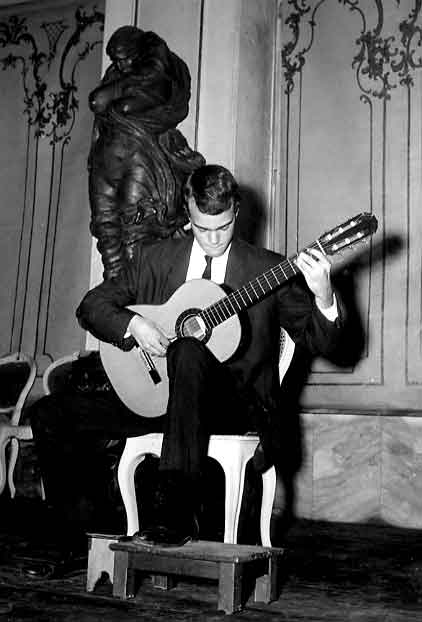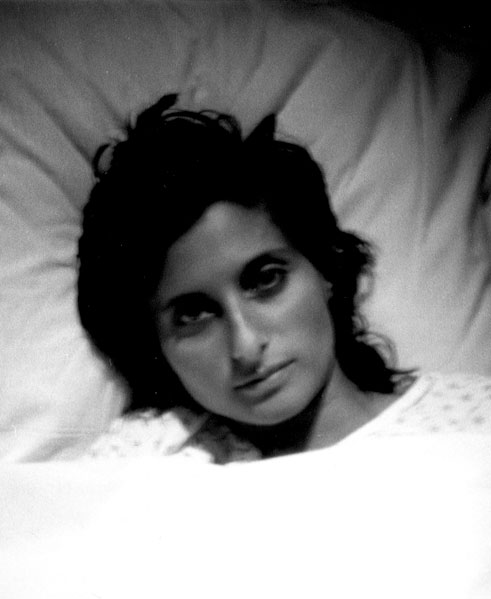|
|
|
EXPERIENCE:
STUDYING WITH AN ARTIST, AND WHAT I LEARNED
I studied with
Andrès Segovia while I was concertising in Europe
as a young man. From this artist who played an average of
one concert every three days for eighty years, I learned
that it is better to move an audience than to amaze them,
and to accept the fact that artistic endeavor is an unrelenting
endurance event. I also learned something else of importance:
that great artists can have equally great aesthetic blindness
(when Stravinsky offered to compose a guitar concerto, Segovia
replied: "Sir, I would not play what you would write.")
From Segovia, therefore, I learned not only to value emotion
and endurance, but, inadvertently, to value the examination
of my artistic repulsions and attractions; and further, to
apply critical judgement to artists in a way that does not
override the appreciation of their contribution.

In recital, Palazzo
Chigi Saracini, Siena, Italy. 1962 (age 18). |
1963-1965
|
|
EXPERIENCE:
WORKING AS A TEACHER, AND WHAT I LEARNED
Years ago I started
a multimedia workshop at Columbia College--an inner city,
open admissions institution with a high minority student
population, specializing in the communications arts, and
with the largest film school in the world. I believed that
the ease with which multimedia techniques could be learned
might allow those who had never had a voice to experience
it for the first time--and in experiencing it, to learn how
to learn. It was true: the artistic work issuing from this
workshop was exhibited nationally (including venues such
as the George Eastman House and San Francisco Cameraworks),
and grade point averages increased. From this, I experienced
the value of the penetration of art into daily life, and
committed myself to the artistic potential of those who are
educationally poor but experientially rich.
|
1977-pres.
|
|
EXPERIENCE:
SEEING A PHOTOGRAPH, AND WHAT I LEARNED
I came across a
photograph of a political prisoner forced to participate
in a medical experiment at Dachau. Fourteen years later,
I was still dreaming of it--so with great trepidation
I began a film based upon the meaning of that photograph
and the historical context from which it was taken. From
this, I experienced how an image can take up "residence"
within an artist and how the fact of that residence can provide
the permission to begin and to endure the making of a work.
|
66-86
|
|
EXPERIENCE:
SERVING AS AN ADMINISTRATOR, AND WHAT I LEARNED
While making EL
MOVIMIENTO , at the encouragement of my dear friend John Mulvany,
I agreed to inaugurate the post of Associate Academic Dean for Technology
and Faculty/Staff Development for three years at Columbia College,
knowing that it would remove the film from my life for that time.
What took its place was the creation and implementation of technology
policies for an institution with 10,200 students and 1,130 faculty.
These policies impacted all areas of the college: organization,
planning, instructional delivery, training, retraining, networks,
administrative services, and technical support (see the complete
"Information Technology
Report" with budget
and appendices). These
initiatives have had a profound and continuing impact on the daily
and artistic lives of students and colleagues. From this experience,
I understood that my time as a dean was a form of artistic community
service--that it was a "work" as grandly structured, detailed,
nurtured, risky and valuable to its audience as any film I could
have made.
|
1995-1998
|
|
EXPERIENCE:
FILMING AND PHOTOGRAPHING AS REMEMBRANCE, AND WHAT I LEARNED
My films and photographs
are intercultural. My hope is that each might take up its
place in the world and exercise its social responsibility
in ways similar to UNIVERSAL
HOTEL:
"As the Director
of the Dachau Concentration Camp Memorial, I have had
the opportunity to view a considerable number of documentaries
recalling the fate of those resisting or suffering the
fate of the Nazi regime. Often filmmakers are striving
to reconstruct history on a large scale…. Your film
uses a completely different approach. Indeed, you offer
the viewer a new mode of vision. Using only a few photographs
and drawings which you collected from different people
and in different countries, you concentrate on one person,
only. With minimal sources, underlined by the account
of your search for information, the film becomes an extraordinarily
moving experience…. Visitors from more than one hundred
different countries visit Dachau each year. Most are young
people. There are many discussions and seminars where
these young people coming from different cultural backgrounds
try to find the meaning of the lesson that can be learned
in Dachau today. Your film "Universal Hotel" has proven
to successfully stimulate intercultural discussions. Spectators
are moved by this forgotten piece of history presented
in an unconventional way. It might help them to understand
and perhaps learn from the past." Letter to the filmmaker,
July 3, 1989, from Barbara Distel, Director of the Dachau
Concentration Camp Memorial.
Dr. Distel describes
a processwhich is itself the goal of all my work:
to allow an historical moment to take up residence; to stay
within the opportunities provided by the specifics of that
historical moment; to shape it so viewers of varied backgrounds
might gain access to it through the artistic experience of
it; to overcome the futility of action through communal remembrance;
to bring the work home–to lodge it within the living
heart of the social context that produced it.
|
80-00
|
|
EXPERIENCE:
TAKING
A PHOTO AND WHAT I LEARNED
When I first went
to Point Lobos, I took along a copy of NOT MAN APART and,
with book open, tried to locate the rocks of my tradition.
A year later I was still locating rocks but working from
MIRRORS, MESSAGES & MANIFESTATIONS. I had already done
the books of Wynn Bullock and Brett Weston. I was a well
grounded photographer.
I knew what was
what. I knew that you bulk ordered your pure white Stoller
mat boards from Germany. You ordered Amidol from England.
You froze your stash of Adox film. You printed with one inch
borders. You looked into East Street Archival Washers, couldn't
afford one, and worried about it. You never took portraits.
You were serious.
It was during this
time that my first wife and I wanted a child. We drove to
the pound and picked out a dog, took her home, gave her a
bath and named her Troika. She grew accustomed to the smell
of stop bath and fixer. She was a photographer's dog.
Her tiny seizures
we passed off as tics until one night--Troika slowly raised
her head, eyes wide and deadened. I whispered --Get your
face away! Izzy rolled at the tone in my voice. Her face
missed the snap. The three of us spent a bad night. Izzy
and I on the bed where we had barricaded ourselves with clothes,
pots, pans and pillows, and Troika under the kitchen table
where she had sought refuge from herself. Throughout the
night jaws snapped shut.
The next morning
I stalked Troika in rubber boots and netted her in a quilt.
Izzy and I wrapped her up gently. She did not struggle. We
drove out the valley to the vet. It was a long drive in bright
day.
--Its distemper,
he said, and shrugged.
We buried Troika
in the quilt under her favorite cypress.
Two weeks later
we were back at the pound. --Troika would want us to do this,
we said. We picked out another dog that looked a little like
Troika, took her home and named her Pooh.
Izzy'sfever
we had passed off--but now here she was in front of me, collapsed
in the supermarket aisle. A fast drive, many hands, the sounds
of game shows from TVs in waiting rooms. Three nights later,
doctors announced that the operation had to be performed
in spite of the fever--soon: in the morning. Izzy said nothing.
We looked at each other. I took out my camera, leaned over
her in the shadows of the sheets, took one exposure and put
the camera down. I then entered into a time of extremity
and photography slipped from my mind.
One year later,
I developed the rolls of film that had accumulated on my
darkroom shelf. The last negative on the last roll was different
from all the others I had ever taken. It was the portrait
of Isabel taken on the night we learned we would not have
children. I saw and understood that this negative was my
first photographic response to the way things happened. I
stopped exhibiting and began again from my own experience,
which has no tradition but uncertainty and time.
|
72-73 |

Copyright © Peter
Thompson, 1973. All rights reserved.
|